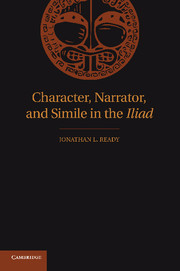Book contents
- Frontmatter
- Contents
- Acknowledgments
- Introduction
- 1 The Simile and the Homeric Comparative Spectrum
- 2 Similes and Likenesses in the Character-Text
- 3 A Preparation for Reading Sequences of Similes
- 4 Sequences of Similes in the Character-Text
- 5 Narrator, Character, and Simile
- 6 Similes in the Narrator-Text
- Conclusion: The Odyssey Compared
- Abbreviations
- Bibliography
- Index Locorum
- Index of Names, Subjects, and Greek Words
5 - Narrator, Character, and Simile
Published online by Cambridge University Press: 03 May 2011
- Frontmatter
- Contents
- Acknowledgments
- Introduction
- 1 The Simile and the Homeric Comparative Spectrum
- 2 Similes and Likenesses in the Character-Text
- 3 A Preparation for Reading Sequences of Similes
- 4 Sequences of Similes in the Character-Text
- 5 Narrator, Character, and Simile
- 6 Similes in the Narrator-Text
- Conclusion: The Odyssey Compared
- Abbreviations
- Bibliography
- Index Locorum
- Index of Names, Subjects, and Greek Words
Summary
chapter 4 explored competitions over simile in the iliad's character-text. This chapter demonstrates that the poet can make similes spoken by characters contest with similes in the narrator-text as well. Before getting to the close readings that as usual make up the bulk of my analysis, I want to review how the narratological work of three different scholars gets us to the point of being comfortable with the claim that the poet can make his characters contest with the narrator.
Irene de Jong observes that a Homeric character does not hear the words of the Homeric narrator. For example, a character is not aware of being made the tenor of a simile by the narrator: “comparisons and similes produced by the NF1 [primary narrator-focalizer] reach the NeFe1 [primary narratee-focalizee] only” (2004a: 125). Even so, through the NeFe1, the historical hearer/reader can compare the different presentations of the narrator and character: “The narratees, who hear the whole text of the story, both narrator-text and (all) speeches, can often detect cross-references which are hidden to the speaking and listening characters.” In a brief survey of some of these “cross-references,” de Jong focuses on moments in which the narrator-text and character-text present the same events and she draws attention to what that contact can reveal about a speaker's aims (2004a: 209–20).
- Type
- Chapter
- Information
- Character, Narrator, and Simile in the Iliad , pp. 150 - 210Publisher: Cambridge University PressPrint publication year: 2011
- 1
- Cited by



